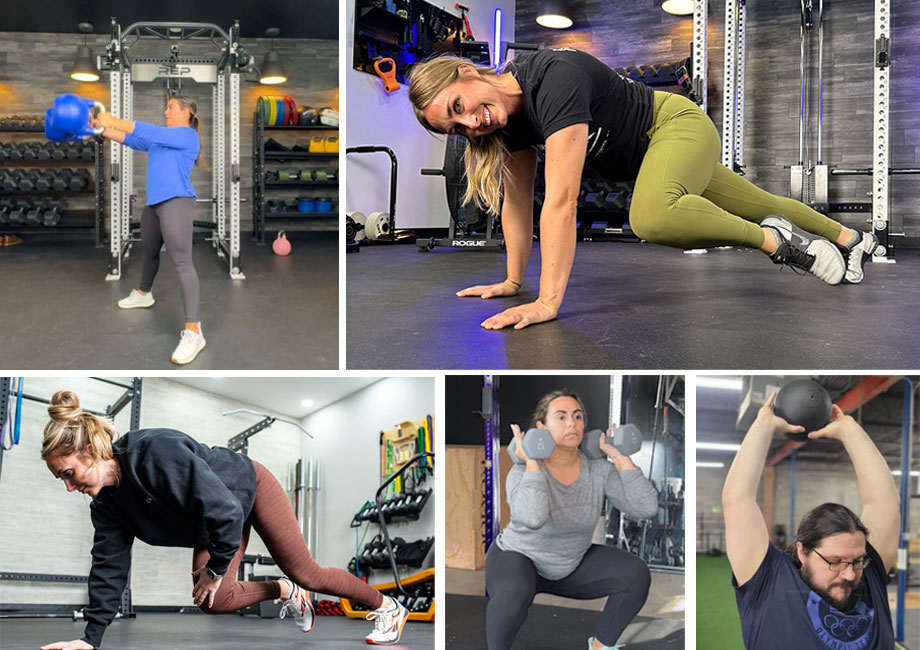We test and review fitness products based on an independent, multi-point methodology. If you use our links to purchase something, we may earn a commission. Read our disclosures.
Whether you love them or hate them, burpees are a fantastic exercise to build strength in the entire body and improve your cardiovascular fitness. That said, it’s always a good idea to know alternative exercises. Regularly performing the burpees exercise may place stress on your joints or—if you’re a beginner—may be too complex to perform with good form. Alternatively, you may just want to add more variety to your training routine.
I’ll begin by explaining what a burpee is before sharing my top 12 burpee alternatives, their benefits, and how to do them with the correct form. Next, I’ll go through three burpee alternative workouts that I would recommend to clients as a longtime certified personal trainer (CPT), and then finish this how-to guide by sharing the benefits of burpee alternatives.
Let’s get into it!
What Is A Burpee?
A burpee is a bodyweight exercise that targets the majority of muscles in the body, including the quadriceps, hamstrings, glutes, core, chest, shoulders, and arms. You often see burpees in high-intensity interval training (HIIT) workouts, but you can also perform them as standalone exercises.
To perform a burpee, begin in a standing position. Squat down and place your hands on the floor in front of you. From here, jump your feet backward to get into the high plank position. From there, perform a push-up (you can consider this optional). Then, jump your feet forward to return to the squat position and jump vertically toward the ceiling. Land on both feet, adjust your position as needed, and go straight into the next repetition.
RELATED: What Muscles Do Burpees Work?
12 Best Burpee Alternatives
- Medicine Ball Slam
- Plank Jack
- Kettlebell Swing
- Inchworm Push-up
- Dumbbell Thruster
- Jump Squat
- Mountain Climber
- Jumping Jacks
- Bear Crawl
- Squat Thrust
- Ski Jump
- Sprawls
Medicine Ball Slam
Muscles worked: Quads, hamstrings, glutes, calves, shoulders, chest, lats, arms, core
Benefits: As with burpees, medicine ball slams target both your upper body and lower body muscles. However, medicine ball slams are more suitable for beginners and those with previous or current injuries because the movement requires less taxation on the joints. Slamming a ball onto the ground can also be a great way to release those daily frustrations.
How to do it:
- Stand tall with your feet shoulder-width apart.
- Grab a medicine ball or one of the best slam balls with both hands, and hold it in front of your chest.
- Squeeze your glutes and engage your core.
- Shift your body weight to the balls of your feet, while simultaneously raising the medicine ball above your head. You’ll want your arms to be fully extended here.
- Slam the ball onto the floor, using as much force as possible.
- Pick up the ball and return to the starting position.
- Continue for the desired number of reps.
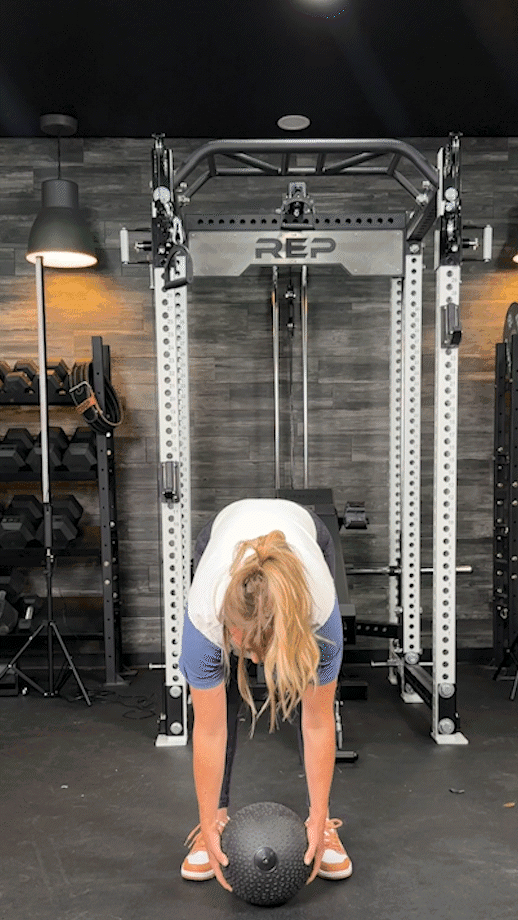
Modifications
- Dial it back: Lower the number of reps or sets, or use a lighter medicine ball. You can also do the exercise while seated or kneeling to reduce the range of motion.
- Make it harder: Use a heavier medicine ball, or increase your number of reps or sets. To fix muscular imbalances and address bilateral deficits1, try single-arm medicine ball slams.
Plank Jack
Muscles worked: Quads, hamstrings, glutes, shoulders, chest, arms, core
Benefits: Plank jacks place more emphasis on core strength and stability than burpees do. This is because you remain in the high plank position for the whole exercise. Most gym-goers find plank jacks easier on the joints than burpees, because with the former, you don’t need to transition from standing to the floor, and then back up again.
How to do it:
- Begin in the high plank position. You’ll want your palms on the floor, shoulder-width apart, your head neutral, and your toes touching the floor.
- Engage your core and squeeze your glutes.
- Kick out both feet at the same time, similar to if you were doing jumping jacks (you’ll see these below!). Your arms should remain fixed in place.
- Bring both feet back into the center.
- Keep going for reps or the desired duration of time.
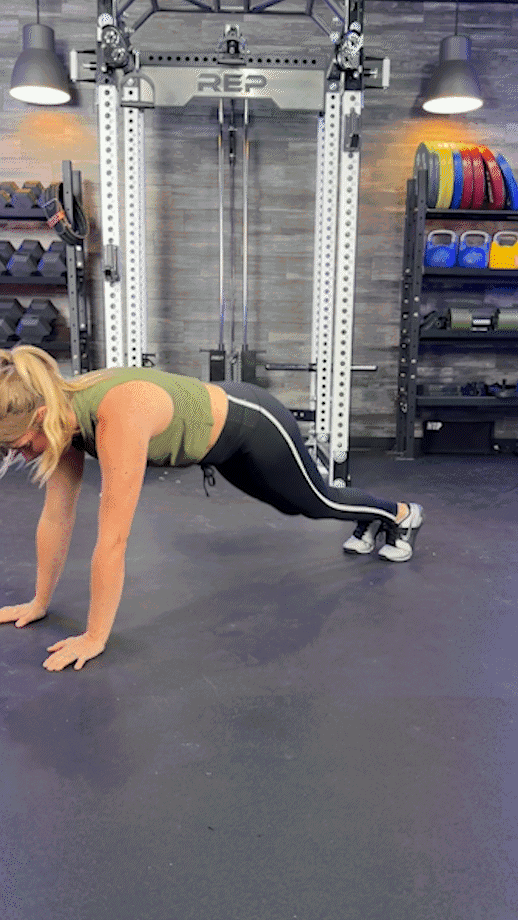
Modifications
- Dial it back: Slow down the pace so that you’re doing the exercise with more control and proper form. Alternatively, instead of jumping both feet out at the same time, step each foot out separately.
- Make it harder: Increase your number of reps or duration. You can also do banded plank jacks by looping one of the best resistance bands around your ankles.
Kettlebell Swing
Muscles worked: Quads, hamstrings, glutes, shoulders, upper back, arms, core
Benefits: According to a 2013 Journal of Strength and Conditioning Research2 controlled clinical trial, “kettlebells may be an effective alternative tool to improve performance in weightlifting and powerlifting.” Therefore, if your primary goal is to improve your lifts, you may be better off doing exercises like kettlebell swings rather than burpees.
How to do it:
- Stand upright with your feet slightly wider than hip-width apart.
- Hold a single kettlebell at your pelvic region. You’ll want to be holding it with both hands, and with an overhand grip (palms facing your body).
- Lift your chest, activate your core, and slightly bend your knees.
- Hinge your torso toward the ground by pushing your hips backward, ensuring that the kettlebell stays between your legs.
- Thrust your hips forward, while simultaneously swinging the kettlebell toward the ceiling. You’ll want your arms to be extended here.
- Pause when the kettlebell reaches chest height (Russian kettlebell swing) or the overhead position (American kettlebell swing).
- Bring the kettlebell to your pelvic region to return to the original position.
- Repeat for reps.
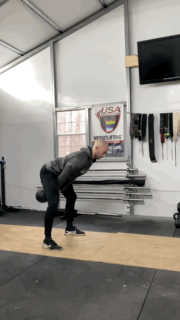
Modifications
- Dial it back: Perform Russian kettlebell swings instead of American kettlebell swings because the former has a shorter range of motion. You can also use a lighter kettlebell, or practice kettlebell deadlifts and Romanian deadlifts to improve your hip extension.
- Make it harder: Increase the weight of the kettlebell or the number of reps you do. If you still find kettlebell swings too easy, progress to double kettlebell swings, single-arm kettlebell swings, or alternating kettlebell swings.
Inchworm Push-up
Muscles worked: Quads, hamstrings, glutes, shoulders, chest, lats, arms, core
Benefits: I love inchworm push-ups because—like burpees—they don’t require equipment. At the same time, they still work muscle groups throughout your entire body. Inchworm push-ups also have a lower impact than burpees because no jumping is involved. The initial part of the movement (before you do the push-up) helps to stretch your entire posterior chain.
How to do it:
- Stand tall with your arms down by your sides and feet shoulder-width apart.
- Place your palms on the floor by bending your knees and hips. You’ll want your palms to be as near to your feet as possible.
- Keep your head neutral, and then walk your hands forward. Keep going until you reach the high plank position.
- Perform a push-up, ensuring that your elbows are tucked into your body.
- Walk your hands backward and return to the standing position.
- Keep going for the desired number of reps.
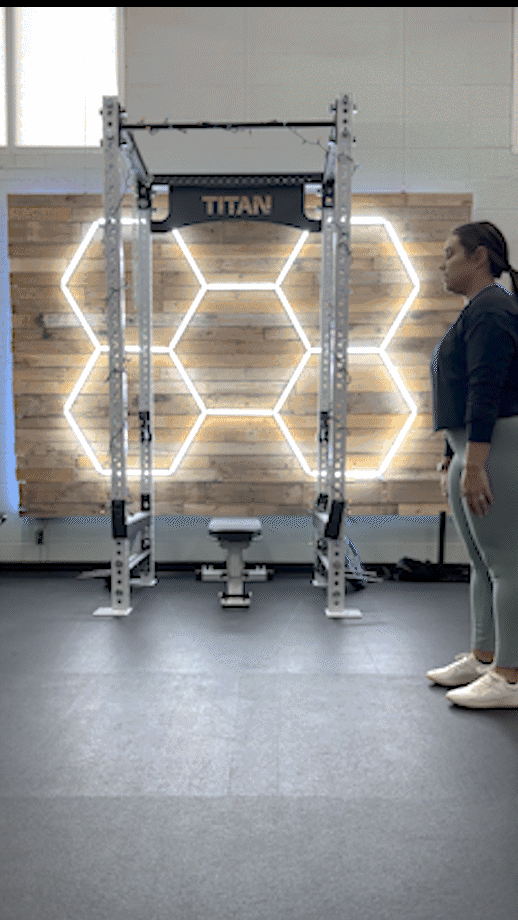
Modifications
- Dial it back: Reduce the number of repetitions or sets you do. If you can’t perform regular push-ups, get onto your knees once you’re in the high plank position.
- Make it harder: To increase your heart rate, jump vertically toward the ceiling at the end of the movement. Alternatively, increase the number of reps or sets, or add extra resistance by wearing one of the best weighted vests.
Dumbbell Thruster
Muscles worked: Quads, hamstrings, glutes, calves, shoulders, upper back, arms, core
Benefits: Unlike traditional burpees, dumbbell thrusters use a pair of dumbbells. This means that although they’re a great cardio exercise, they also help to build strength and explosive power. As you saw with burpees, dumbbell thrusters are a full-body exercise, and the squat and overhead press elements mimic real-life fundamental movements (for example, sitting on a chair or placing an object on a shelf).
How to do it:
- Stand upright with your feet hip-width apart. You’ll want to be holding a pair of dumbbells, one in each hand, and your hands positioned at shoulder height.
- Activate your core and squeeze your glutes.
- Squat down, similar to if you were sitting on a chair.
- When you reach at least parallel (if not deeper), push through your heels to return to the standing position.
- As you stand, use the momentum to press the dumbbells overhead. Keep going until your arms and legs are straight.
- Hold momentarily, and then lower the dumbbells back down to shoulder height.
- Continue for repetitions.
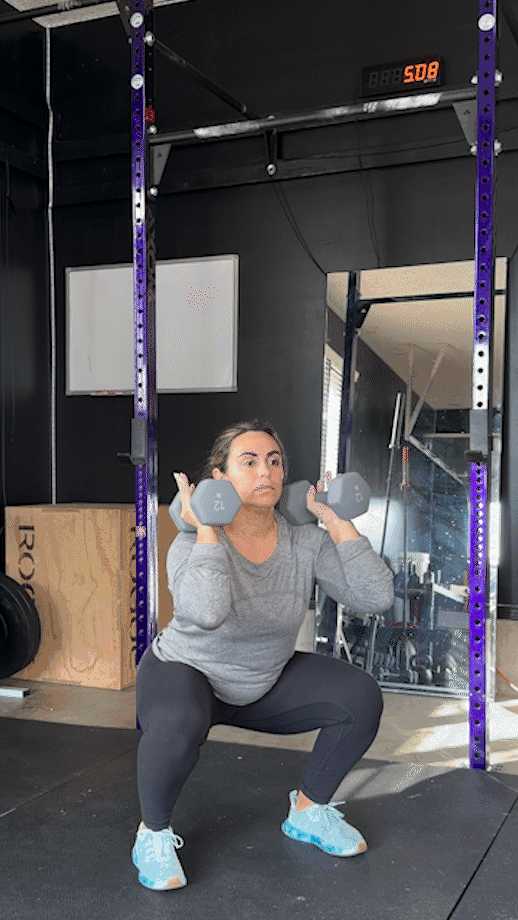
Modifications
- Dial it back: Decrease the weight of the dumbbells, or reduce the number of repetitions or sets. If you’re not comfortable doing a full squat to begin with, do partial squats. Aim to get slightly lower each week until you reach at least parallel.
- Make it harder: Use heavier dumbbells, or increase the pace so that the movement is more fluid. If you want to correct muscular imbalances on each side of the body, do single-arm dumbbell thrusters instead.
RELATED: Best Dumbbells
Jump Squat
Muscles worked: Quads, hamstrings, glutes, calves, core
Benefits: Jump squats are included in the GGR guide to squat variations, and for good reason. Not only do they improve your cardiovascular fitness, but they also strengthen your lower body. From my experience working with clients as a CPT, jump squats can be easier to learn and more suitable for beginners than burpees.
How to do it:
- Stand tall with your feet hip-width apart.
- Place your arms in your desired position. They can either be down by your sides, across your chest, or extended in front of your body for balance.
- Squeeze your glutes and brace your core.
- Squat down, ensuring that your knees are aligned with your toes. Continue until your quads are at least parallel to the ground.
- Push through your heels to jump vertically toward the ceiling. You’ll want to be at least two inches off the floor, if not more.
- Land softly with both feet, and then adjust your foot positioning if required.
- Repeat the movement for reps or time.
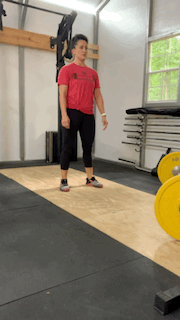
Modifications
- Dial it back: Perform bodyweight squats instead of jump squats if you find the jumping element challenging. Alternatively, do fewer reps, or decrease the height of your jump.
- Make it harder: The best way to make jump squats harder is to add extra resistance. You can do this by holding a pair of dumbbells by your sides, or by wearing a weighted vest. Otherwise, aim to increase the height of your jump.
Mountain Climber
Muscles worked: Quads, hamstrings, glutes, shoulders, chest, arms, core
Benefits: Mountain climbers are a fantastic addition to any workout routine because you can adapt them for different fitness levels. They can also be performed from nearly anywhere (similar to burpees). Having done mountain climbers for the past 10 years as part of my routine, I’ve found that they engage my core muscles more than burpees.
How to do it:
- Begin in the high plank position. Your body should form a straight line from crown to toe, your head should be neutral, and your palms should be shoulder-width apart.
- Engage your core and squeeze your glutes.
- Lift your left foot off the floor and bring your left knee toward your left elbow. Your right foot should remain fixed on the ground.
- Bring your left foot back to its original position and immediately repeat on the opposite side, bringing your right knee toward your right elbow.
- Continue for repetitions or the desired duration, alternating sides each time.
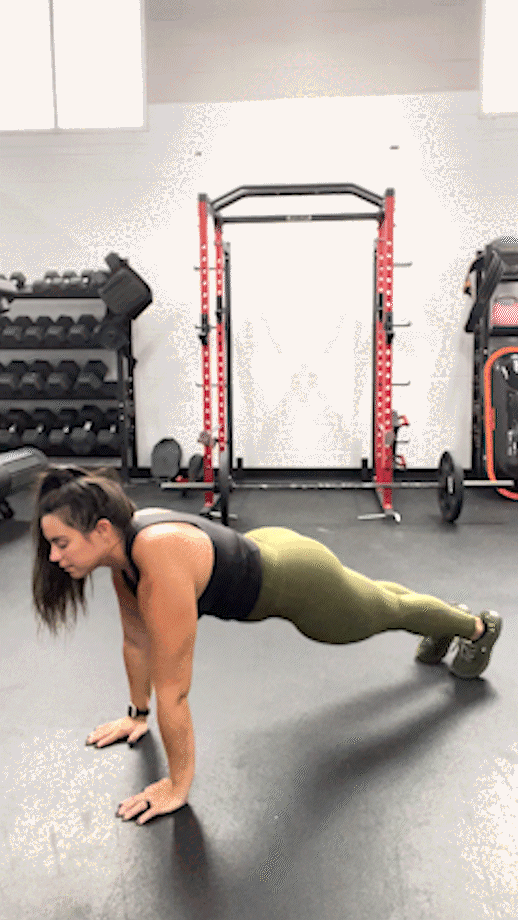
Modifications
- Dial it back: Place your hands on an elevated surface instead of the floor. For example, you can use a weight bench, a plyometric box, or even a chair. Another option is to slow down the exercise, allowing you to focus on maintaining the proper form.
- Make it harder: Instead of regular mountain climbers, try cross-body mountain climbers. These activate your obliques and hip flexors to a greater degree than regular mountain climbers do. Alternatively, increase the speed or duration.
Jumping Jacks
Muscles worked: Quads, hamstrings, glutes, calves, shoulders, lats, arms, core
Benefits: Most people can do jumping jacks for a longer period than they can do burpees, making them a great cardio exercise. This is because burpees are high-impact, while jumping jacks are moderate-impact. You’ll also improve your coordination with jumping jacks, especially when you progress to more advanced versions (check out the two examples below).
How to do it:
- Stand upright with your arms down by your sides and your feet shoulder-width apart.
- Squeeze your glutes and activate your core.
- Jump both feet out at the same time, while simultaneously bringing your arms above your head so that your hands are close to touching.
- Reverse the motion so that your feet pop back to center, with your arms down by your sides.
- Repeat for reps or desired duration.
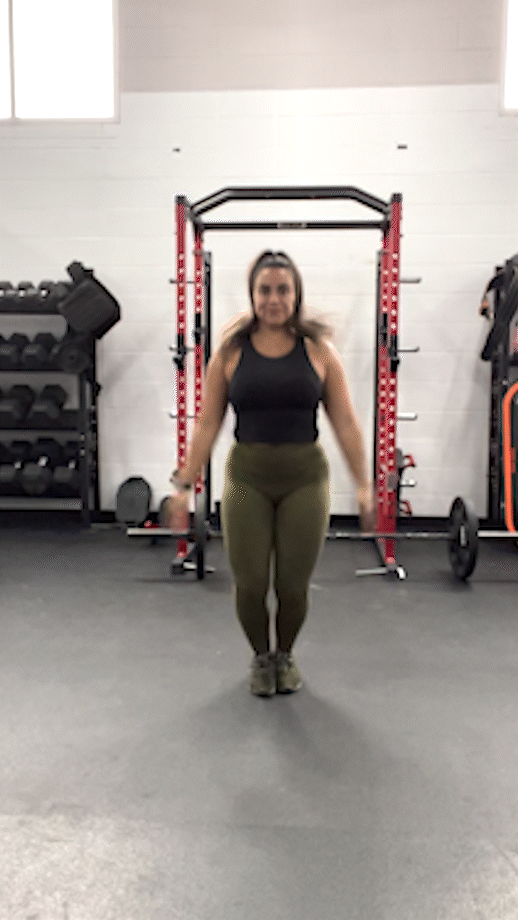
Modifications
- Dial it back: Instead of jumping both feet out together, step each foot out separately. You can also reduce the number of reps or the length of time.
- Make it harder: Hold a pair of light dumbbells in your hands while doing jumping jacks. You can also try squat jacks (which is where you add a squat at the end of a jumping jack), or burpee jacks (adding a jumping jack at the end of a burpee).
Bear Crawl
Muscles worked: Quads, hamstrings, glutes, calves, shoulders, chest, lats, arms, core
Benefits: Bear crawls are a full-body workout, strengthening your upper body, lower body, and core. Because they don’t require any equipment, you can add them to your home workout (similar to burpees). Regularly performing bear crawls will also build your mental toughness because—speaking from experience—they’re one of the most challenging exercises on this list.
How to do it:
- Begin on the floor, placing your hands, knees, and toes on the ground. You’ll want your palms to be shoulder-width apart, and your knees directly underneath your hips.
- Activate your core, keep your head neutral, and then lift your knees roughly a few inches off the ground. Your hands and toes should remain fixed in place.
- Step forward by using your left hand and right foot at the same time.
- When you move forward again, use your right hand and left foot.
- Keep going for the desired distance or time, alternating sides.
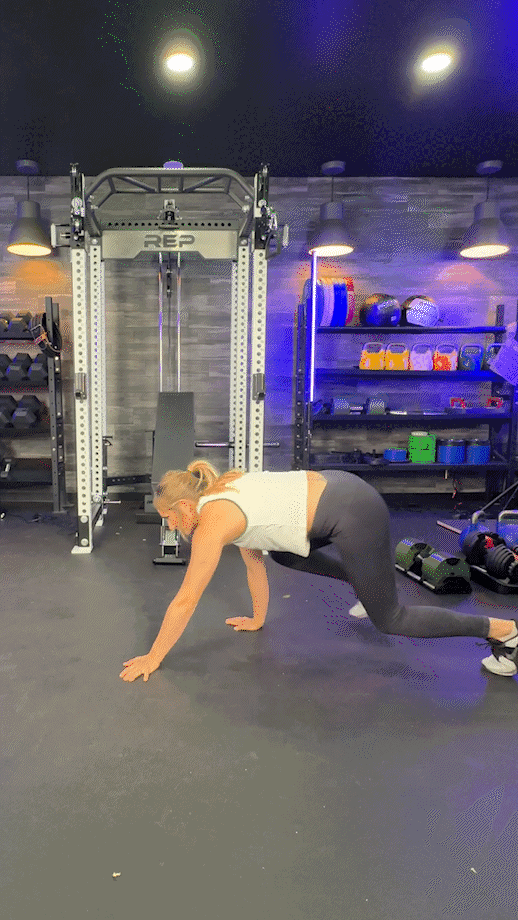
Modifications
- Dial it back: Reduce the distance or the length of time that you crawl. You can also start with the bird dog exercise or donkey kicks to start building up the muscle and coordination needed to bear crawl.
- Make it harder: If you’re up for it, try bear crawl sled drags by securing one of the best weight sleds to your torso and performing the bear crawl exercise as described above. Alternatively, increase your speed, distance, or time.
Squat Thrust
Muscles worked: Quads, hamstrings, glutes, calves, shoulders, chest, arms, core
Benefits: Because of the nature of this exercise, squat thrusts target the core muscles to a greater extent than burpees do. You’ll also improve your hip mobility, which helps with exercises such as back squats and deadlifts. If your goal is weight loss, squat thrusts burn a lot of calories—but you’ll still need to make sure you’re in a calorie deficit.
How to do it:
- Begin in the high plank position. Your palms should be shoulder-width apart, your head should be neutral, and your body should form a straight line from crown to toe.
- Squeeze your glutes and brace your core.
- Jump both feet simultaneously toward your hands. Your hands should remain fixed in place, and your feet should land flat on the ground.
- Hold momentarily, and then reverse the motion by jumping your feet backward.
- Repeat for repetitions or the desired time.
Modifications
- Dial it back: Rather than attempting to jump your feet close to your hands, reduce the range of motion by aiming for a more comfortable foot position. If jumping your feet forward and backward is difficult, step each foot in and out separately.
- Make it harder: Increase the number of reps, speed, or time. You can also loop a resistance band around your quads to add extra resistance.
Ski Jump
Muscles worked: Quads, hamstrings, glutes, calves, core
Benefits: Ski jumps are low-impact compared to burpees because you don’t get onto the floor and back up. At the same time, they improve your cardiovascular fitness and build muscle in your lower body. I also like that ski jumps involve a lateral movement rather than a vertical movement, improving your athletic performance for sports such as tennis or skiing.
How to do it:
- Stand tall with your arms down by your sides and your feet together.
- Bend your knees to squat down. You’ll want to position your arms in front of you, similar to if you were skiing.
- Lift your chest up, keep your head neutral, and engage your core.
- Jump vertically and to your left side, ensuring that you land on both feet.
- Return to the original position on the next rep by jumping up and to your right side.
- Continue for reps or the desired length of time, alternating sides each time.
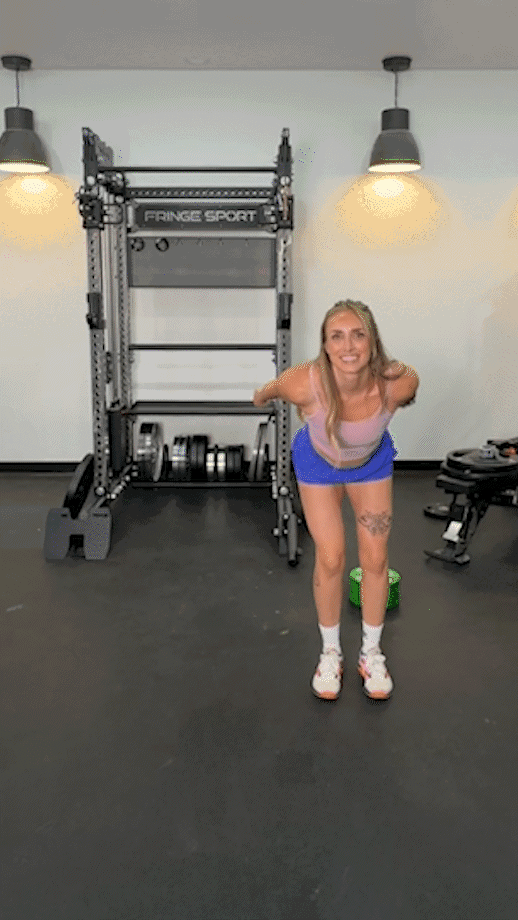
Modifications
- Dial it back: For those who aren’t able to jump to the side, step to the side instead. Alternatively, reduce the pace, time, or the distance you jump.
- Make it harder: Increase the length of time that you perform the exercise, or the jump distance or height. Another option is to add extra resistance by holding a light dumbbell in each hand, wearing a weighted vest, or looping a resistance band around your quads.
Sprawls
Muscles worked: Quads, hamstrings, glutes, calves, shoulders, chest, arms, core
Benefits: Sprawls—as we saw with burpees—work the full body. However, sprawls are more suitable for beginners or those with current or previous injuries because there are fewer movements involved. If you hate burpees but want the cardiovascular and strength benefits that burpees offer, consider incorporating sprawls into your training regimen.
How to do it:
- Stand upright with your feet hip-width apart and arms down by your sides.
- Activate your core and squeeze your glutes.
- Squat down, similar to if you were sitting on a chair. Keep going until your quadriceps are parallel to the ground.
- Hold the squat position, and then clasp your hands in front of your chest. This is your starting position.
- Place your palms on the ground, as close to your toes as possible. At the same time, jump both feet backward so that you’re in the high plank position.
- Pause before jumping both feet toward your hands. Return to the squat position.
- Keep going for reps.
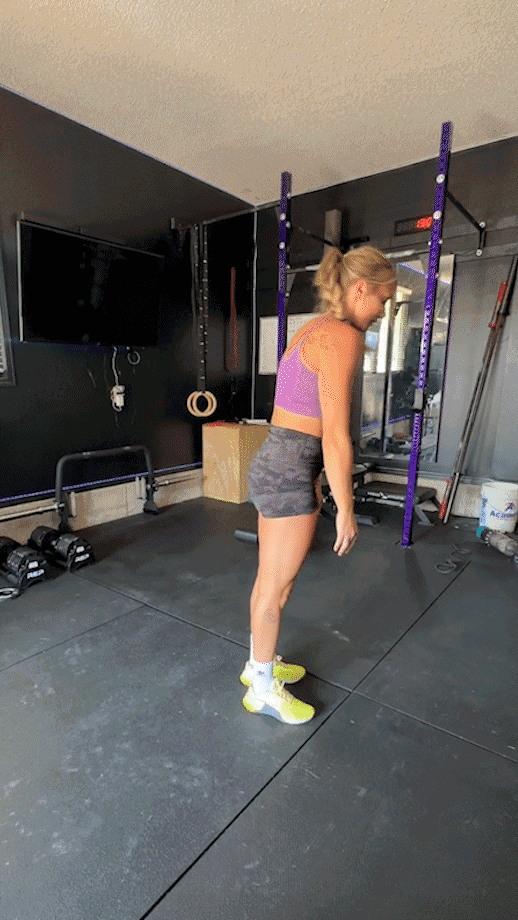
Modifications
- Dial it back: Place your hands on a weight bench or plyometric box to make the exercise easier. Or, step each foot out separately instead of jumping both feet out.
- Make it harder: Increase the speed or number of reps. Alternatively, when you’re in the high plank position, perform a push-up to place more emphasis on your upper body.
Sample Burpee Alternative Workouts
Before you try the above exercises, I’ve given three sample burpee alternative workouts below that I’d recommend to clients. The first is for beginners, the second is for hypertrophy, and the third is for muscular endurance.
Burpee Alternative Workout for Beginners
For beginners, there are four exercises and 10 sets in total. The first two exercises involve equipment, so they’ll increase your strength, while the third and fourth exercises will improve your cardio. Between each set, rest for roughly one minute. If medicine ball slams or dumbbell thrusters become too easy, increase the weight. You can also increase the duration of time for jumping jacks and ski jumps if 30 seconds isn’t enough.
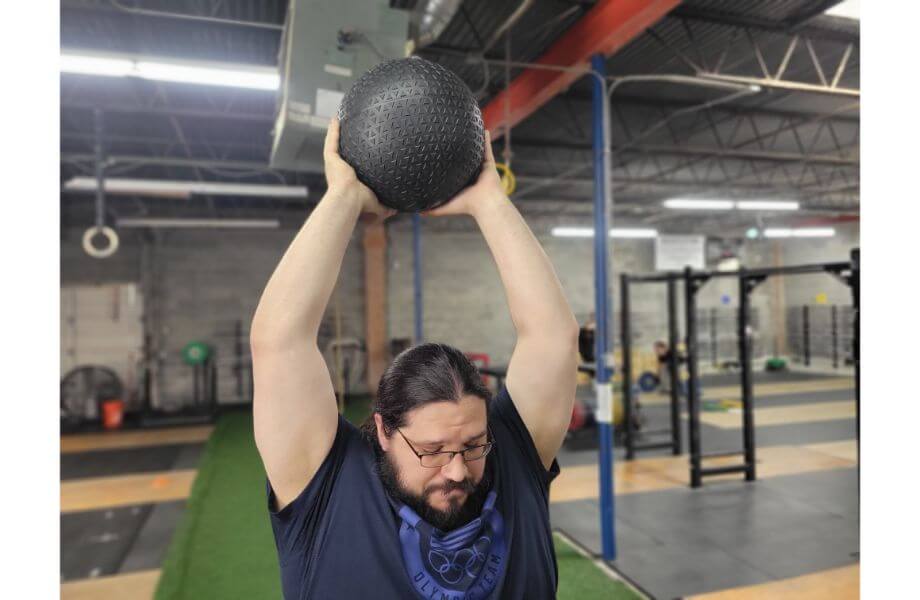
For your warm-up, do three to five minutes on a cardio machine, then perform dynamic exercises such as bodyweight squats, leg swings, arm swings and circles, resistance band pull-aparts, and more.
RELATED: Best Cardio Machines
| Exercise | Sets | Reps/Time |
| Medicine Ball Slam | 3 | 10 |
| Dumbbell Thruster | 3 | 10 |
| Jumping Jacks | 2 | AMRAP* in 30 sec |
| Ski Jumps | 2 | AMRAP in 30 se |
*As many reps as possible
Equipment needed: Medicine ball, dumbbells
Burpee Alternative Workout for Hypertrophy
If you want to increase your muscle size, your burpee alternative workout should be more intense. I’ve included five exercises for a total of 17 sets because this is what it takes to gain muscle. You’ll likely need around 90 seconds of rest between each set. Increase the weight of the kettlebell if kettlebell swings aren’t challenging enough, or do bear crawls for a longer duration.
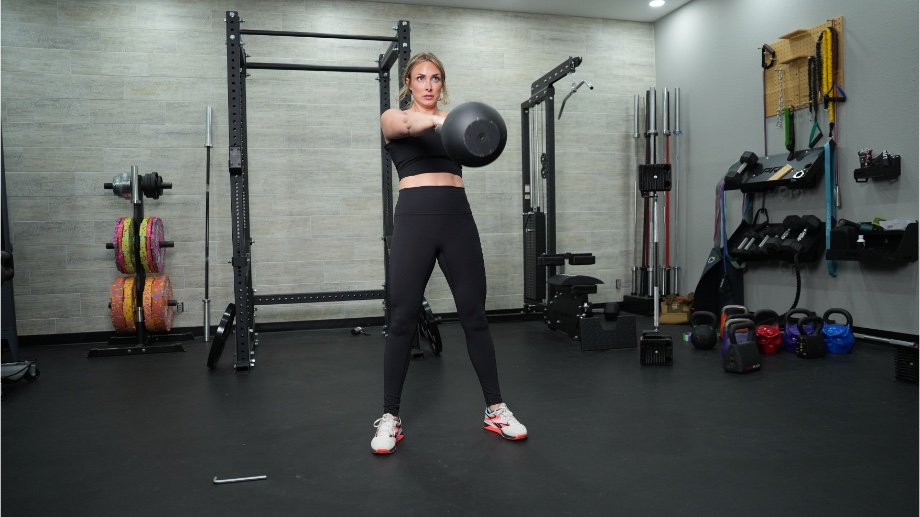
Perform a similar warm-up to the one described above—a combination of cardio and dynamic exercises.
| Exercise | Sets | Reps/Time |
| Kettlebell Swing | 4 | 8 |
| Inchworm Push-up | 4 | 8 |
| Bear Crawl | 3 | AMRAP in 30 sec |
| Squat Thrusts | 3 | 12 |
| Mountain Climber | 3 | 8, each side |
Equipment needed: Kettlebell
Burpee Alternative Workout for Muscular Endurance
Next, I have four muscular endurance exercises for 12 sets altogether. You’ll do higher reps than what you saw with the hypertrophy workout above. For kettlebell swings, this means you’ll need to reduce the weight of the kettlebell. Because your goal is muscular endurance, rest for less time (between 30 and 60 seconds) between sets.
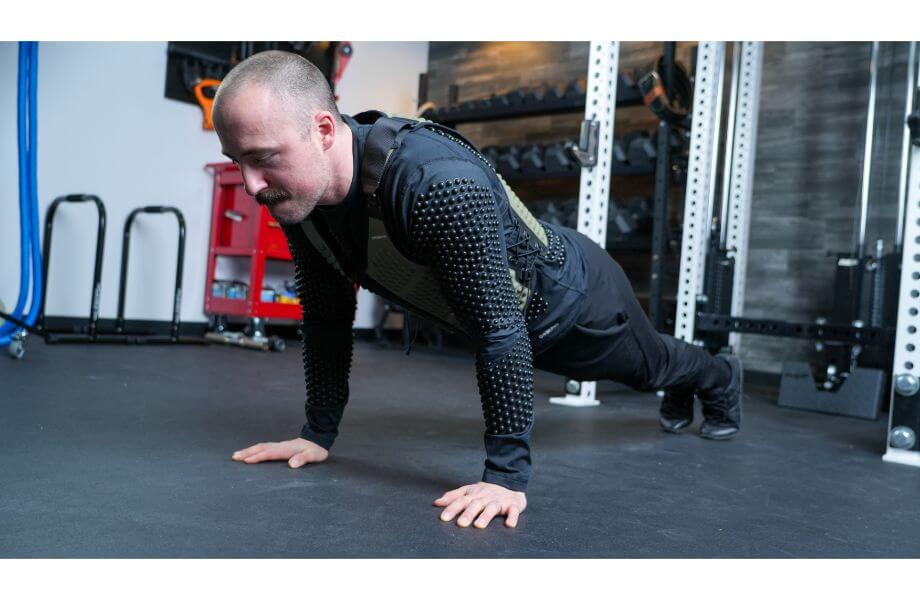
Again, do a warm-up that includes cardio and dynamic exercises.
| Exercise | Sets | Reps |
| Kettlebell Swing | 3 | 15 |
| Jump Squat | 3 | 15 |
| Plank Jack | 3 | 15 |
| Sprawls | 3 | 15 |
Equipment needed: Kettlebell
Benefits of Burpee Alternatives
Alternative exercises—especially when it’s a more advanced movement—can be easier to learn, place less strain on your joints, and add variety to your training. Allow me to expand on this:
They’re More Beginner-Friendly
Burpees are complex to learn, especially if you want to do them with the correct form. You go from a squat to a high plank to a push-up to a jump. For beginners, this may be too complicated. Instead, you can get similar strength and cardiovascular benefits from burpee alternatives that you can get from burpees. Then, perhaps you can try burpees at a later stage.
They’ll Place Less Strain On Your Joints
According to a 2019 Journal of Sports Medicine and Physical Fitness3 study, exercises like burpees, push-ups, lunges, and more may be more likely to cause injuries, especially knee and ankle sprains and strains. While burpee alternatives can’t protect you from injuries altogether, some lower-impact exercises reduce your injury risk.
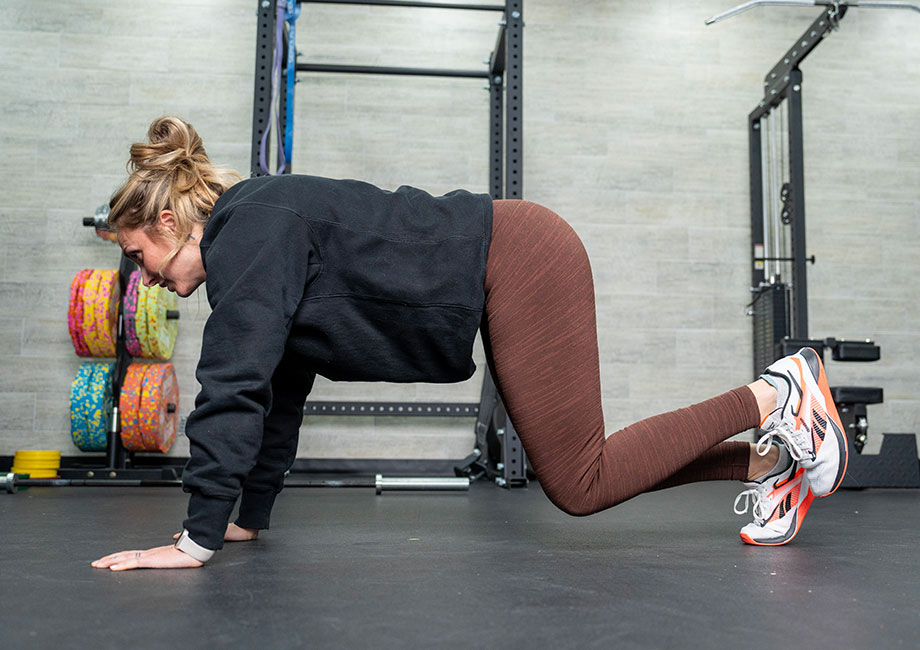
They Can Add More Variety To Your Training
Doing the same exercise time and time again can get demotivating. I love burpees and have included them in my workouts for the past 10 years, but sometimes, I need a break. Instead, I turn to my list of burpee alternatives and choose an exercise I want to do rather than forcing myself to do one I don’t.
Burpee Alternatives: Final Thoughts
Although I’m a big fan of the burpee exercise, there are several reasons why you may want burpee alternatives. Burpees may be causing you pain or discomfort in your joints, or if you’re a beginner, they may be too complex. Alternatively, you might just want to add more variety to your workout routine.
I recommend trying all 12 burpee alternative exercises listed above and choosing the three or four exercises you enjoy the most. Once you find them, perform them regularly to build strength in the entire body and improve your cardiovascular health.
Burpee Alternatives: FAQs
What is the easy version of the burpee?
The easier, modified burpee still targets the same muscle groups as the standard burpee but is less intense. To do the easy version, begin by standing upright. Squat down and place your hands on the floor in front of you. Instead of jumping backward, step each foot back separately until you’re in the high plank position.
Don’t perform a push-up next but hold the plank position momentarily. Then, step each foot forward separately before returning to the squat position. There’s no jump involved at this point—instead, you’ll stand up tall and reach both arms toward the ceiling.
What exercise is better than burpees?
Exercises that can be used as alternatives to burpees include:
– Medicine Ball Slam
– Plank Jack
– Kettlebell Swing
– Inchworm Push-up
– Dumbbell Thruster
– Jump Squat
– Mountain Climber
– Jumping Jacks
– Bear Crawl
– Squat Thrust
– Ski Jumps
– Sprawls
As a fitness professional, I won’t say that some or all of these burpee alternatives are better than burpees themselves because this comes down to individual preferences. Try the above exercises and decide for yourself if they’re better than burpees.
Are burpees worth doing?
You may hear different answers from different trainers, but in my opinion, burpees are worth doing and are a fantastic way to build full-body strength and improve your cardio fitness. They’re functional, too, because they involve movements such as squats and jumps, which mimic everyday movements. However, it’s important to note that burpees can place stress on the joints for some people due to their intensity, so if this is you, it may be worth trying burpee alternatives instead.
References
- Škarabot J, Cronin N, Strojnik V, Avela J. Bilateral deficit in maximal force production. Eur J Appl Physiol. 2016 Dec;116(11-12):2057-2084. doi: 10.1007/s00421-016-3458-z. Epub 2016 Aug 31. PMID: 27582260.
- Manocchia P, Spierer DK, Lufkin AK, Minichiello J, Castro J. Transference of kettlebell training to strength, power, and endurance. J Strength Cond Res. 2013 Feb;27(2):477-84. doi: 10.1519/JSC.0b01 3e31825770fe. PMID: 22549084.
- Rynecki ND, Siracuse BL, Ippolito JA, Beebe KS. Injuries sustained during high intensity interval training: are modern fitness trends contributing to increased injury rates? J Sports Med Phys Fitness. 2019 Jul;59(7):1206-1212. doi: 10.23736/S0022-4707.19.09407-6. Epub 2019 Feb 12. PMID: 30758171.
Further reading

Learn how to do the reverse fly exercise with our step-by-step guide. Read more

HawkGrips are IASTM tools that are made of stainless steel and some of the best available. They're high-quality, incredibly useful, and beautiful. We highly recommend them to practitioners and people that like nice bodywork tools. Read more

Best Low-Carb Protein Powder Read more

If you’re debating using a treadmill vs recumbent bike, we have some key considerations for you. Read more

